Best hearing aids of 2025
Our team compared the best hearing aids for 2025 based on features, pricing, and customer care to help you make the right decision for your needs.
What is a hearing aid?
A hearing aid is an electronic device designed to improve hearing in noisy and quiet environments. It works by magnifying sound frequencies entering the ear.
Hearing aids have one or two microphones to pick up sound, an amplifier to make the sound louder, and a receiver to transmit the amplified sound to the middle ear. Beyond the basic operating parts, companies offer hearing aid devices with different designs, features, and technology.
Hearing aids versus cochlear implants
Hearing aids and cochlear implants are designed to assist people with hearing loss, but they function differently and address different types of hearing impairments. Hearing aids are external devices that amplify sounds for individuals with mild to moderate hearing loss.
Cochlear implants require surgical insertion and are designed for individuals with severe hearing loss. They bypass damaged parts of the ear and use electrical signals to stimulate the auditory nerve directly. The choice between the two typically depends on the degree of hearing loss, with cochlear implants being a solution for more severe cases where traditional hearing aids do not provide sufficient benefit.
How do hearing aids work?
Hearing aids are worn in or behind your ear. They’re designed to make certain sound frequencies louder to improve your hearing and speech comprehension. A microphone inside the hearing aid first picks up sounds, which are then analyzed and converted to electrical signals. These signals are then sent to the amplifier.
The now amplified sounds are sent to the speaker or receiver, which are transmitted to the inner ear by a tube or thin wire. Once in the inner ear, the sounds are transformed into electrical impulses, which your brain turns into sound.
Digital vs. analog hearing aids
Hearing aids are available in analog or digital. Although digital is the most common type of device, a few companies still carry analog hearing aids. The difference between analog and digital devices comes down to the type of electronics used. Both devices convert sound waves, but the process used sets each type apart. U.S. Food and Drug Administration. Types of Hearing Aids. Found on the internet at https://www.fda.gov/medical-devices/hearing-aids/types-hearing-aids
With an analog hearing aid, you will experience amplification with all sounds, including noise and speech. In other words, they make continuous sound waves louder. Analog hearing aids require the user to change settings when in different environments, but some people feel that analog devices provide a more natural hearing experience.
Digital hearing aids convert sound waves to digital signals, providing the clearest hearing possible. These devices can clear out background noise, reduce feedback, and help you focus on the sounds and voices you want to hear. They also offer more complex programming, which allows you to process sounds more selectively.
Types of hearing aids
The five main types of hearing aids have their own pros and cons.
Completely-in-the-canal (CIC) hearing aid
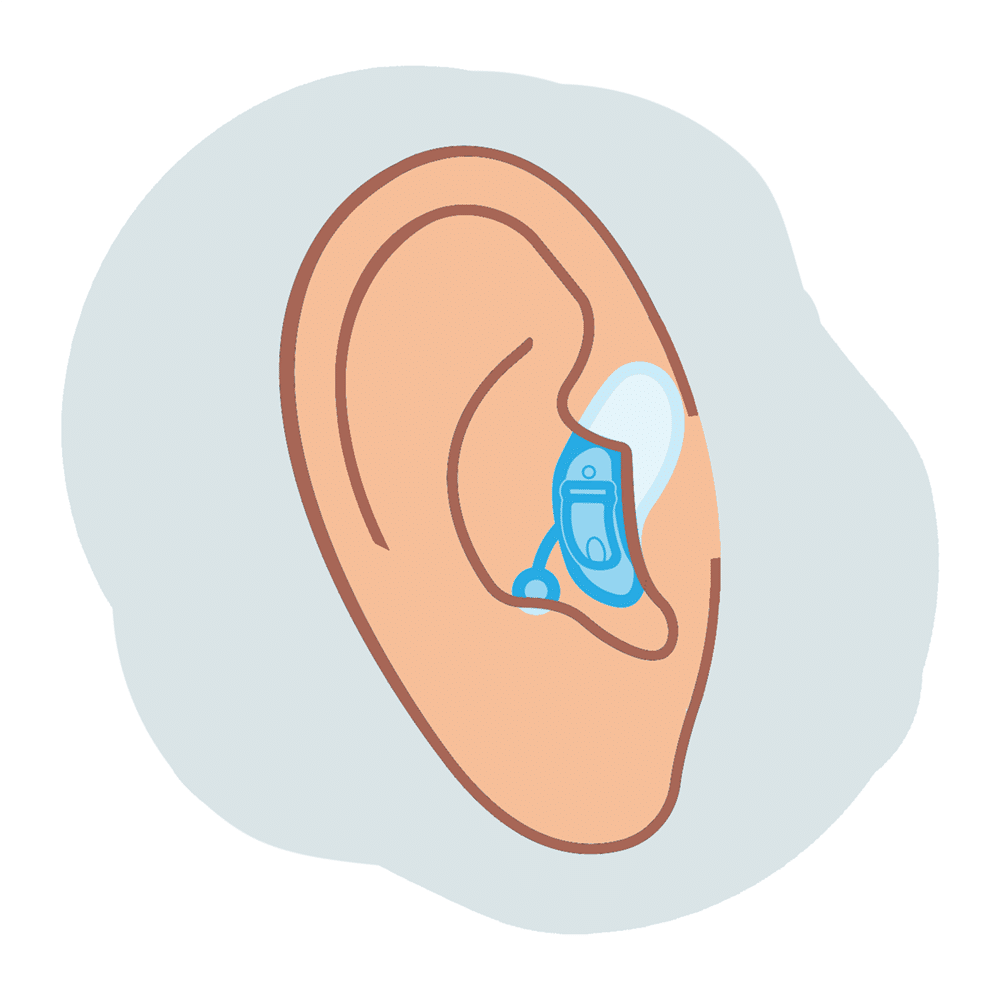
Also called a mini CIC, this hearing aid is the smallest and least visible device for treating hearing loss. It is positioned completely within the ear canal, and a tiny string allows you to remove the device.
In addition to an invisible fit, CIC devices offer the advantage of less feedback when using a telephone and less disruptive noise from the wind.
Due to their small size, CIC hearing aids may not have some of the features you’d get with other larger devices, such as Bluetooth streaming and rechargeable batteries. Some CIC hearing aids are also too small for a directional microphone. Battery life may also be shorter due to the small size of the device, and ear wax and moisture can affect their function.
One subtype of CIC hearing aid is the invisible-in-canal (IIC) style. The Phonak Lyric comes in this style. Sitting deep in the ear canal, IIC hearing aids are truly invisible when properly inserted.
In-the-canal (ITC) hearing aid
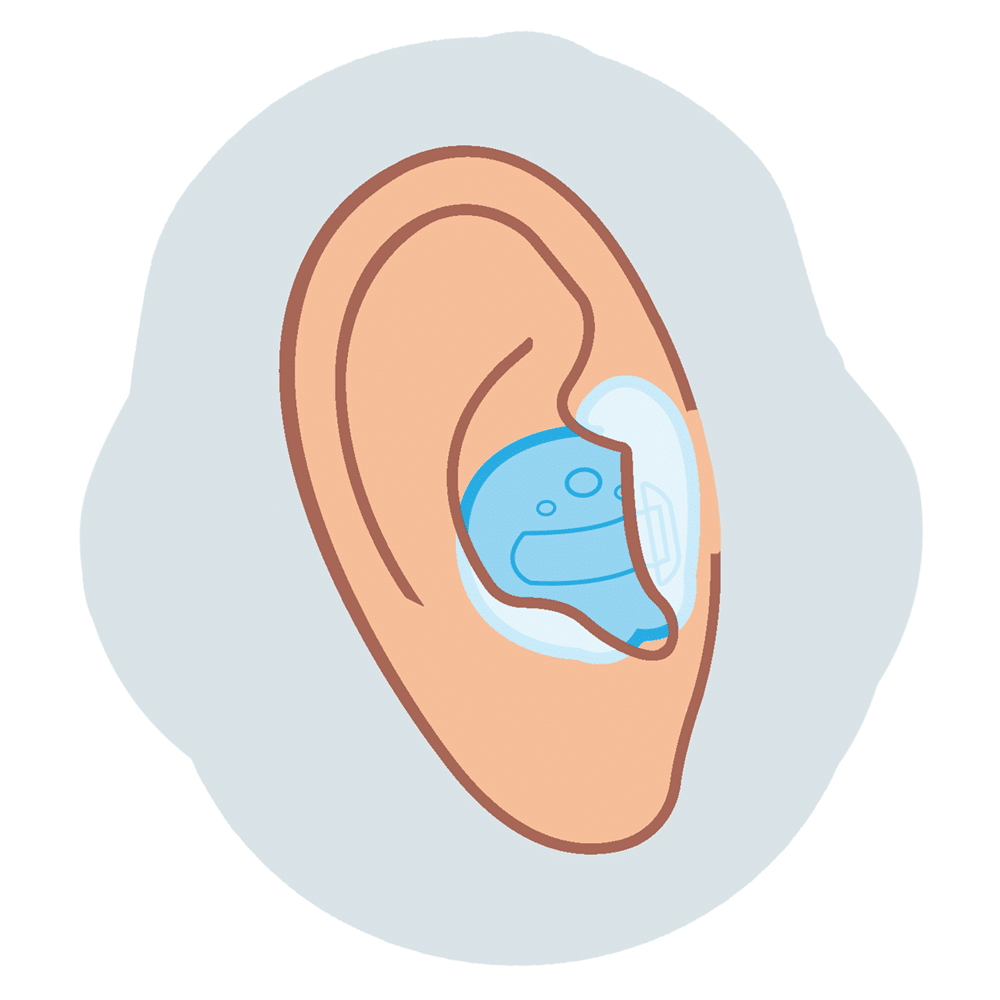
This hearing aid sits deep in the ear canal, but it’s a bit larger and more visible than a CIC device. ITC hearing aids allow for longer battery life than many CIC devices, as well as directional microphones. But they are still susceptible to issues with earwax and moisture, and may be difficult for some people to handle due to their relatively small size.
Behind-the-ear (BTE) hearing aid
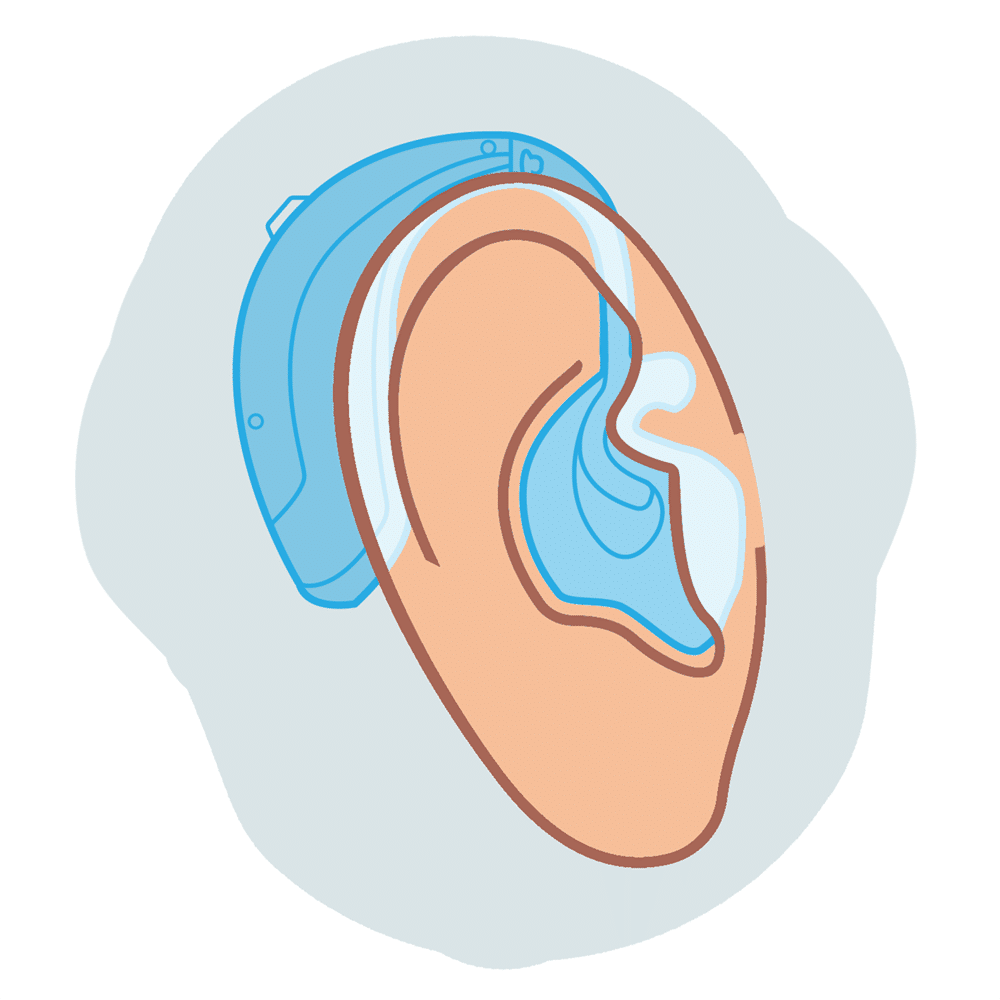
This device sits behind your ear and includes a plastic tube that hooks over your ear to reach the ear canal. At the end of the tube is a dome or custom-fit ear mold that sits snugly within the canal.
These devices tend to be larger than in-the-ear or in-the-canal hearing aids, but they offer more capabilities, such as directional microphones and a telecoil, which can help you hear better on the telephone and with assisted listening devices. They’re also easier to handle and can be a better choice for people with severe or profound hearing loss.
Receiver-in-canal (RIC) hearing aid
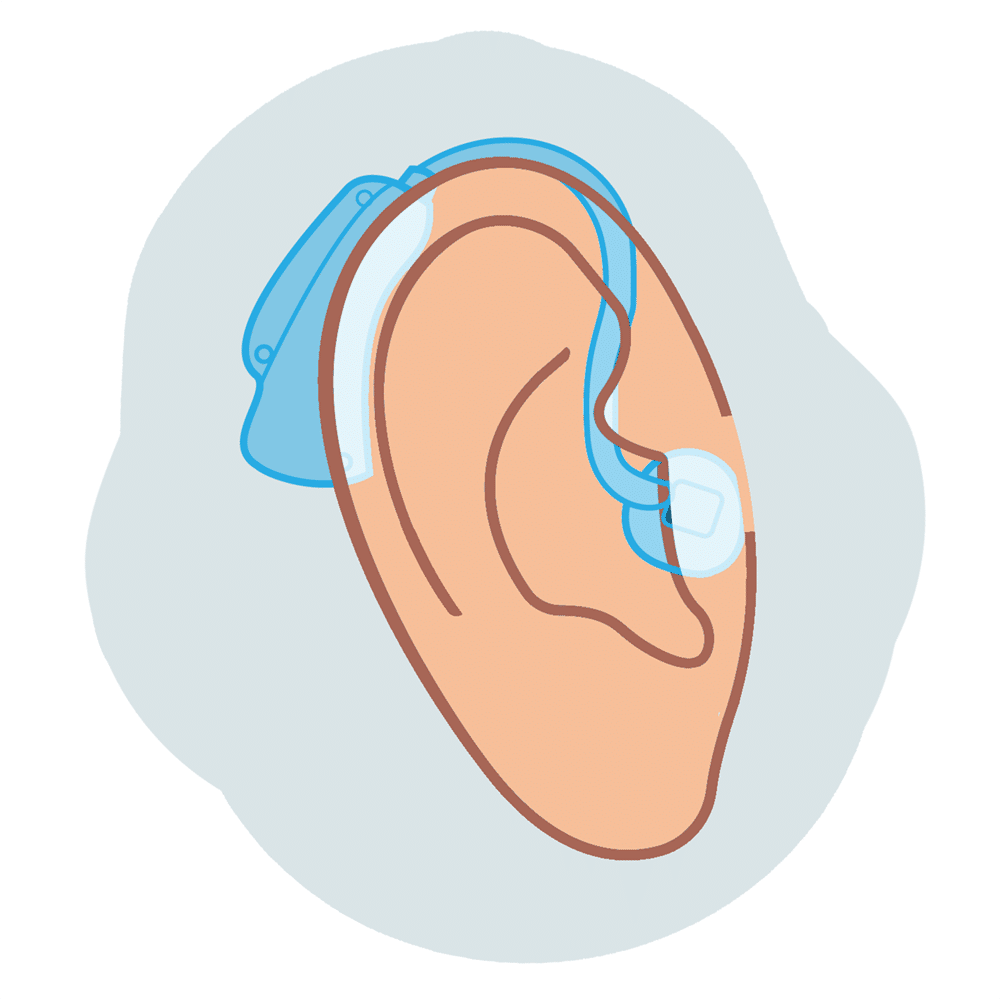
Also referred to as receiver-in-the-ear (RITE) or mini behind-the-ear (mBTE), RIC devices sit behind the ear like traditional types but are smaller and less visible, especially when you choose one that matches your hair color. They have a tiny wire encased in silicone tubing that hooks over the ear and connects to a small receiver that fits inside the ear canal.
For many users, these devices strike the perfect balance between looks and functionality.
In-the-ear (ITE) hearing aid
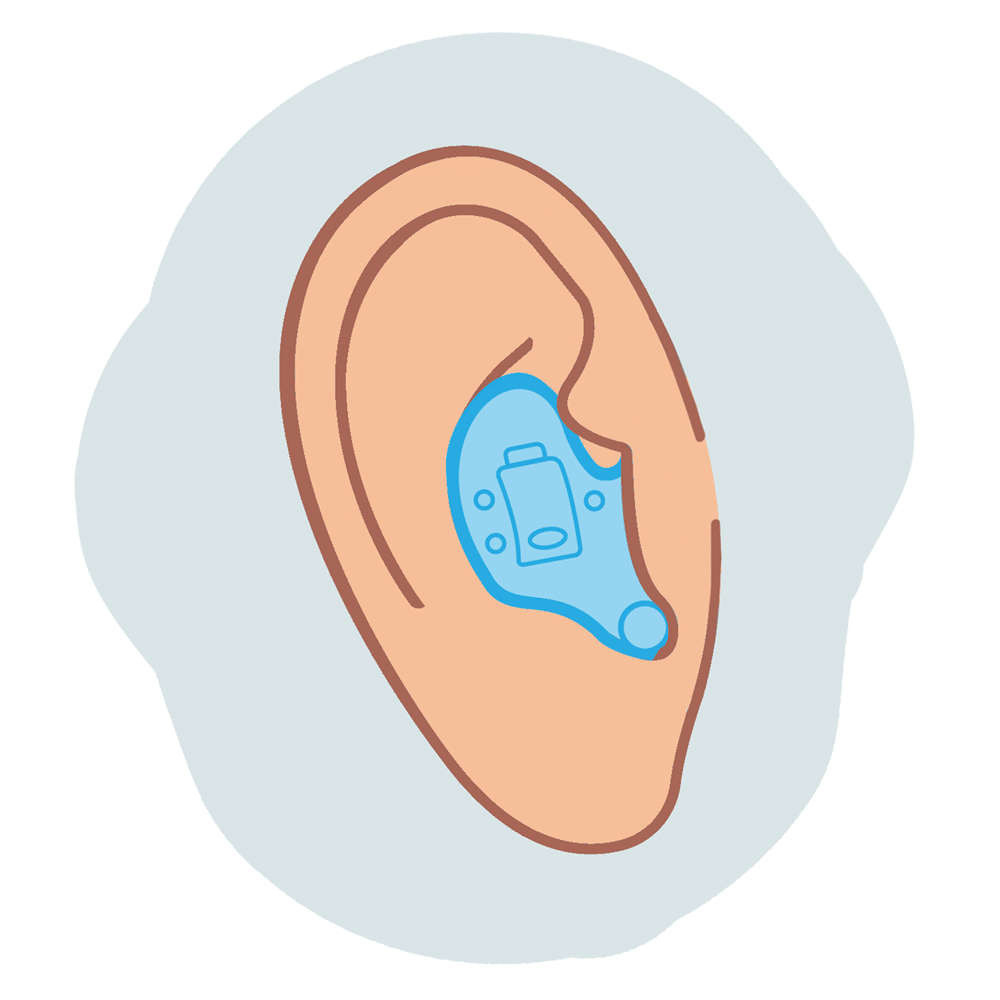
This type of hearing aid sits completely within the ear but is larger than the CIC style. ITE hearing aids are generally large enough to offer advanced features such as Bluetooth, directional microphones, and a telecoil, but the smaller size may limit their power compared to BTE models. ITE hearing aids are typically easier to handle and insert than their smaller counterparts, but they may also be more visible.
What to consider before buying a hearing aid
The National Institute on Deafness and Other Communication Disorders (NIDCD) reports that 37.5 million American adults have some level of hearing loss. While hearing loss can occur at any time in life, the problem becomes more common with age.
The NIDCD estimates almost one in four adults between the ages of 65 and 74 and half of people older than 75 have disabling hearing loss. So it may come as a surprise that only one in three adults who could benefit from hearing aids has ever used them.National Institute on Deafness and Other Communication Disorders. Quick Statistics About Hearing. Found on the internet at https://www.nidcd.nih.gov/health/statistics/quick-statistics-hearing
People with hearing loss may not seek help for a variety of reasons, including:
- The cost of hearing aids and hearing care
- The fact that some insurance companies and Medicare plans do not cover hearing aids
- Distance from hearing care providers
- The stigma associated with wearing a hearing aidThe Gerontologist. The Stigma of Hearing Loss. Found on the internet at https://academic.oup.com/gerontologist/article/50/1/66/692298
We asked Michelle Brady, an audiologist with Access Audiology, a mobile audiology service in the New York City area, what she’d like people to know about the purchasing process. According to Brady, the most important thing to consider when shopping for a hearing aid is time.
“Research has shown that the longer hearing loss goes untreated, the [more the] brain’s ability to understand and decode speech decreases,” Brady said. “Just like muscles in the body—if you don’t use it, you lose it. Unfortunately, hearing aids cannot override the damage that occurs from years of decreased auditory stimulation. The earlier a patient gets hearing aids and wears them consistently, the better their brain will be able to process and decode speech.”
Hearing loss has also been associated with higher rates of falls, depression, and social isolation among older adults. Getting your hearing checked and corrected can play an important role in improving your quality of life.
What older adults look for in hearing aids
Older adults concerned with the visibility of a hearing aid should consider in-the-ear (ITE) models that are more discreet compared to behind-the-ear (BTE) options. Additionally, if you are not particularly tech-savvy or just want a hearing aid that has the easiest setup, it might be beneficial to consider a more basic hearing aid device without too many complex features. On the other hand, if you’re comfortable with smartphones, apps, and customizing your own settings, a more advanced model does offer more overall convenience in terms of operations.
How much do hearing aids cost?
The cost of hearing aids largely depends on whether you’re purchasing OTC or prescription hearing aids, as well as the battery type (disposable or rechargeable), features, and sound technology. In fact, hearing aid pricing ranges widely: from $99 to $7,000.
How to find affordable hearing aids
Hearing aids are an investment. Even the most inexpensive hearing aids cost around $300 per pair.
MDHearing, for example, sells budget-friendly digital hearing aids starting at $999.98 per pair (before promotions). Audien offers low-cost devices starting at $99 per pair, but they’re very basic compared to other hearing aids on the market.
Before buying a lower-cost model, make sure to check the fine print. Some retailers and online distributors advertise low-cost hearing aids but are actually selling PSAPs, which amplify sound but do not provide the same level of support or technology as a hearing aid.
Hearing aids are typically sold through hearing care clinics or larger retailers, like Walmart or Costco. But you can also find inexpensive OTC hearing aids online through companies like MDHearing, Jabra Enhance, Lexie, and Eargo.
If you need a prescription hearing aid that’s only offered through a hearing care clinic, consider purchasing through an authorized discount supplier, such as Yes Hearing, which sells high-quality hearing aids, like Phonak and Signia, at a reduced cost. You still work with a local audiologist to get fitted and set up with your device, while the supplier manages the purchasing process with your hearing provider. This option could save you hundreds of dollars.
How to care for your hearing aids
Maintaining and taking care of your hearing aids will ensure they function properly and have a long battery life. You should clean your devices regularly, according to the manufacturer’s instructions, as substances like ear wax and fluids, including ear drainage, can cause damage to your hearing aids. You should also avoid moisture (especially if your devices are not water resistant), as well as high temperatures. It’s also best to remove your hearing aids when using hair products. When it comes to battery life, make sure you change disposable batteries as soon as they die and turn off your hearing aids whenever they are not in use.
The future of hearing aids
With so many advances in technology, it’s no surprise the future of hearing aids is especially bright. Manufacturers continue to innovate to offer consumers the best hearing solutions possible through state-of-the-art sound technology.
Newest hearing aid technology in 2024
According to the National Institute on Deafness and Other Communication Disorders, researchers are heavily invested in learning how to apply new signal processing tactics to hearing aids. Additionally, computer-aided technology systems are being utilized to improve design components. New ideations surrounding improved sound transmission and reduced background noise are also underway, as are advancements in enhanced Bluetooth connectivity, rechargeable batteries, and telehealth capabilities for remote adjustments and fittings.National Institute on Deafness and Other Communication Disorders. Hearing Aids. Oct. 11, 2022. Found on the internet at https://www.nidcd.nih.gov/health/hearing-aids
Still, studies focused on how to choose and fit hearing aids for certain groups of people, including children, are in the works, with scientists running directional microphone tests on the ear structure of a tiny fly.
Additionally, the use of Bluetooth connectivity continues to advance with major hearing aid makers because it improves our daily quality of life. Some of the best Bluetooth hearing aids offer multi-device streaming and connectivity so you can switch seamlessly from your smartphone to your television. It won’t be long before more brands implement better Bluetooth features, too. With Bluetooth and smartphones top of mind, we can expect a more upgraded smartphone app experience as well.
Plus, well-known hearing aid brands, like Oticon and Widex, are already using artificial intelligence (AI) features for auto-adjustment, user inputs, and to power natural sound. And it won’t be a surprise if big brand collaborations are in store from household names, like Apple and Samsung, which are already extremely sound-oriented.
The rise in popularity of telehealth services now includes hearing health care, too. When it comes to methods of shopping for hearing aids, we expect more companies to begin offering full-service in-home prescription hearing aids to consumers, with models similar to hear.com.
Hearing aids and health
We know that hearing aids improve the health of users by improving their hearing, but research also suggests that mitigating hearing loss can improve the overall health of older adults.
The National Institutes of Health’s news publication, NIH Research Matters, reports on the connection between cognitive decline and hearing loss in a new study looking at the connection between hearing aids and slowing cognitive decline. While no significant difference was found in cognitive decline between those who did and did not receive hearing aids when they analyzed the entire population of study participants, a 50% decrease in cognitive decline was seen in those who were at a higher risk of cognitive decline and received a hearing aid.
Falls-related injuries pose a significant health risk for older adults, who are 2.4 times more likely to experience falls if they have hearing loss, according to the Journal of The American Geriatrics Society. In their research, however, they found that consistent use of hearing aids is associated with a 50% decrease in falls compared to those who don’t consistently use hearing aids.
We also witness a connection between hearing loss and mental health. It’s normal to experience feelings of social isolation or anxiety about communication if your hearing has changed over time, but isolation and communication difficulties can contribute to depression and anxiety. Seeing a doctor about hearing loss, and using hearing aids to improve hearing, can help to mitigate mental health symptoms in those experiencing hearing loss.
Sources
- Centers for Disease Control and Prevention. Facts About Falls. Found on the internet at https://www.cdc.gov/falls/about/index.html
- John Hopkins Medicine. Hearing Loss Linked to Three-Fold Risk of Falling. Feb. 27, 2012. Found on the internet at https://www.hopkinsmedicine.org/news/media/releases/hearing_loss_linked_to_three_fold_risk_of_falling
- Rock Health. Consumer Adoption of Digital Health in 2022: Moving at the Speed of Trust. Feb. 21, 2023. Found on the internet at https://rockhealth.com/insights/consumer-adoption-of-digital-health-in-2022-moving-at-the-speed-of-trust/
- U.S. Food and Drug Administration. Types of Hearing Aids. Found on the internet at https://www.fda.gov/medical-devices/hearing-aids/types-hearing-aids
- Federal Register. Medical Devices; Ear, Nose, and Throat Devices; Establishing Over-the-Counter Hearing Aids. Found on the internet at https://www.federalregister.gov/documents/2022/08/17/2022-17230/medical-devices-ear-nose-and-throat-devices-establishing-over-the-counter-hearing-aids
- OTC Hearing Aids: What You Should Know. U.S. Food & Drug Administration. May 3, 2023. Found on the internet at https://www.fda.gov/medical-devices/hearing-aids/otc-hearing-aids-what-you-should-know
- National Institute on Deafness and Other Communication Disorders. Over-the-Counter Hearing Aids. Found on the internet at https://www.nidcd.nih.gov/health/over-counter-hearing-aids
- Smith, D, et al. Acceptability, Benefits and Costs of Early Screening for Hearing Disability: A Study of Potential Screening Tests and Models. November 2007. Found on the internet at https://www.journalslibrary.nihr.ac.uk/hta/hta11420/#/full-report
- National Institute on Deafness and Other Communication Disorders. Quick Statistics About Hearing. Found on the internet at https://www.nidcd.nih.gov/health/statistics/quick-statistics-hearing
- Wallhagen, Margaret. The Stigma of Hearing Loss. The Gerontologist. February 2010. Found on the internet at https://academic.oup.com/gerontologist/article/50/1/66/692298
- Centers for Disease Control and Prevention. Understanding Hearing Loss. Aug. 7, 2023. Found on the internet at https://www.cdc.gov/ncbddd/hearingloss/parentsguide/understanding/understandinghearingloss.html
- Mayo Clinic. Hearing aids: How to choose the right one. Found on the internet at https://www.mayoclinic.org/diseases-conditions/hearing-loss/in-depth/hearing-aids/art-20044116
- National Institute on Deafness and Other Communication Disorders. Hearing Aids. Oct. 11, 2022. Found on the internet at https://www.nidcd.nih.gov/health/hearing-aids
- Mayo Clinic. Hearing Loss. Found on the internet at https://www.mayoclinic.org/diseases-conditions/hearing-loss/symptoms-causes/syc-20373072
- Harvard Health Publishing. One Hearing Aid or Two? Found on the internet at https://www.health.harvard.edu/diseases-and-conditions/one-hearing-aid-or-two
- Source: NIH Research Matters. Hearing aids slow cognitive decline in people at high risk. Found on the internet at: https://www.nih.gov/news-events/nih-research-matters/hearing-aids-slow-cognitive-decline-people-high-risk









